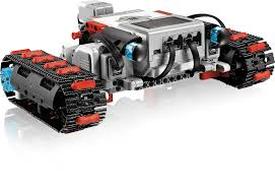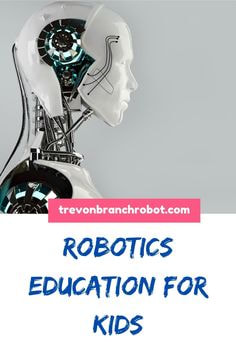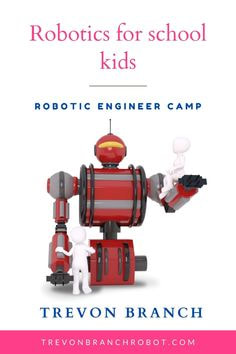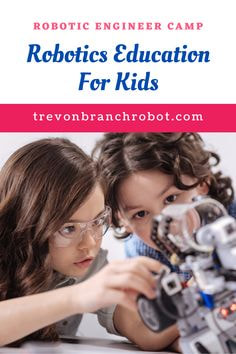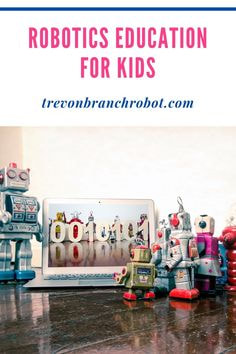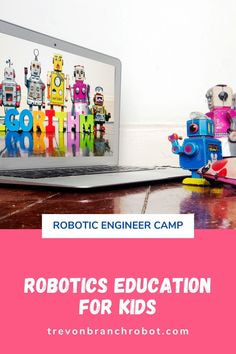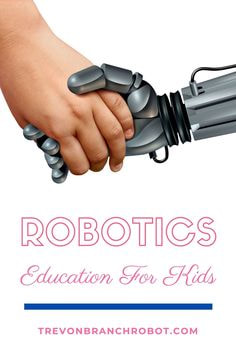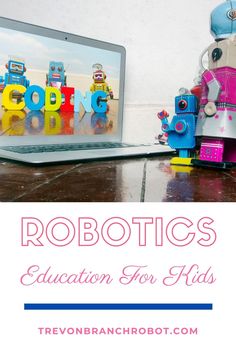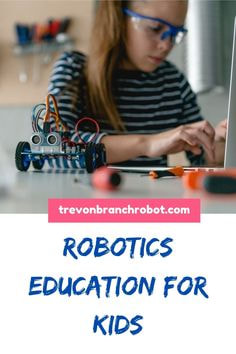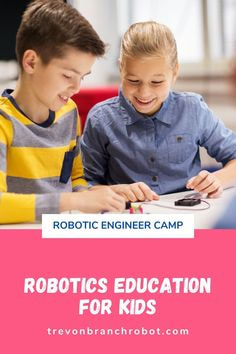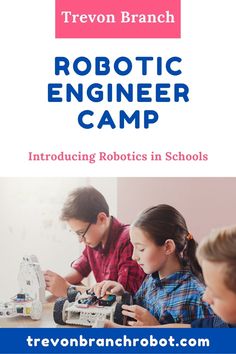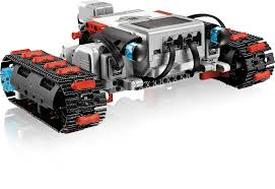METHODOLOGY
EV3 code is aimed at all operators and uses a straight forward block oriented language. Experienced campers may want to try a more sophisticated language . This camp introduces beginning and advanced young engineers to program design that takes place in a genuine but educational setting. The physical robots reacts to the program writer’s commands and each camper is then provided with spontaneous feedback to help them develop their programming proficiency.
EV3 code is aimed at all operators and uses a straight forward block oriented language. Experienced campers may want to try a more sophisticated language . This camp introduces beginning and advanced young engineers to program design that takes place in a genuine but educational setting. The physical robots reacts to the program writer’s commands and each camper is then provided with spontaneous feedback to help them develop their programming proficiency.
WHY IT WORKS
The robot reacts to the computer programmer’s instructions and each learner is provided with instant feedback to help them acquire important skills. Robotics permits learners to come together and invent, plan and solve problems . This exciting process naturally enhances their understanding of mathematics, science and technology.
The robot reacts to the computer programmer’s instructions and each learner is provided with instant feedback to help them acquire important skills. Robotics permits learners to come together and invent, plan and solve problems . This exciting process naturally enhances their understanding of mathematics, science and technology.
Example Challenges:
1)
When the switch is pressed both motors will turn at half speed in opposite directions and the green light ill turn on. When the bumper switch is pressed and released the left motor will stop and the red light will turn off. When the bumper switch is pressed and released again the left servo will turn off.
Use what this initial program is teaching you to write your own similar set of code . Be sure to start with a new template program to ensure every step is included. The blank lines in the code are to help show the six separate parts of the program. Show instructor the program when complete.
1)
When the switch is pressed both motors will turn at half speed in opposite directions and the green light ill turn on. When the bumper switch is pressed and released the left motor will stop and the red light will turn off. When the bumper switch is pressed and released again the left servo will turn off.
Use what this initial program is teaching you to write your own similar set of code . Be sure to start with a new template program to ensure every step is included. The blank lines in the code are to help show the six separate parts of the program. Show instructor the program when complete.
2)
Wait until the bumper switch is pressed and released, turn the motors on in opposite directions at half speed, wait until the line follower reads 1050 , start both motors, restart both motors at full speed in opposite directions for fourteen seconds, speed up both motors to full speed, and stop them both once the line follower reads a level lower than (lighter than) 1000. Run the sample program. Then, take what the program taught you to write your own similar program. Show instructor the program when working .
Wait until the bumper switch is pressed and released, turn the motors on in opposite directions at half speed, wait until the line follower reads 1050 , start both motors, restart both motors at full speed in opposite directions for fourteen seconds, speed up both motors to full speed, and stop them both once the line follower reads a level lower than (lighter than) 1000. Run the sample program. Then, take what the program taught you to write your own similar program. Show instructor the program when working .
Instructor asks students for ideas about what they need to do to modify their robots to be the best Sumo wrestler it can be (direct students to think about mass and center of gravity as discussed above) The instructor explains that robo-Sumo, like the Japanese wrestling contest, is the challenge in which two robots challenge each other within a ring. Instructor will demonstrate this lesson prior to afternoon competitions.
Physical Science
Substances react chemically in characteristic ways with other substances to form new substances (compounds) with different characteristic properties. In chemical reactions, the total mass is conserved. Substances often are placed in categories or groups if they react in similar ways; metals are an example of such a group.
Earth Science
The atmosphere is a mixture of nitrogen, oxygen, and trace gases that include water vapor. The atmosphere has different properties at different elevations.
Science in Personal and Social Perspectives
• Technology influences society through its products and processes. Technology influences the quality of life and the ways people act and interact. Technological changes are often accompanied by social, political, and economic changes that can be beneficial or detrimental to individuals and to society. Social needs, attitudes, and values influence the direction of technological development.
• Science cannot answer all questions and technology cannot solve all human problems or meet all human needs. Students should understand the difference between scientific and other questions. They should appreciate what science and technology can reasonably contribute to society and what they cannot do. For example, new technologies often will decrease some risks and increase others.
• Scientists formulate and test their explanations of nature using observation, experiments, and theoretical and mathematical models. Although all scientific ideas are tentative and subject to change and improvement in principle, for most major ideas in science, there is much experimental and observational confirmation. Those ideas are not likely to change greatly in the future. Scientists do and have changed their ideas about nature when they encounter new experimental evidence that does not match their existing explanations.
• It is part of scientific inquiry to evaluate the results of scientific investigations, experiments, observations, theoretical models, and the explanations proposed by other scientists. Evaluation includes reviewing the experimental procedures, examining the evidence, identifying faulty reasoning, pointing out statements that go beyond the evidence, and suggesting alternative explanations for the same observations. Although scientists may disagree about explanations of phenomena, about interpretations of data, or about the value of rival theories, they do agree that questioning, response to criticism, and open communication are integral to the process of science. As scientific knowledge evolves, major disagreements
Supporting concepts:
1) Structural Formula. 6) Photosynthesis 11) Respiration
2) Greenhouse effect. 7) Chemical Formula 12) Hydrocarbon
3) Global warming. 8) Organic molecules 13) Carbon Cycle
4) Law of conservation of energy. 9) Combustion. 14) Structural Formula
5) Law of conservation of matter. 10) Chemical Equation
Learning Activities
Task #1
Instructional Objectives
Students will learn how to draw chemical and structural formulas for a number of Hydrocarbon molecules.
At the completion of this lesson, students will;
1) Be able to create chemical formulas for molecules
2) Be able to create structural formulas for molecules
3) Be able to name various hydrocarbons and create and utilize a mnemonic device to remember their names
Engagement
“Prince Phillip Came Over From Germany Swimming”
a) Students will be asked “Who has used an acronym to learn something?”
We will go over some common example + examples students may know: “Please Excuse My Dear Aunt Sally” ..etc.
Exploration
We will explore a special class of Carbon-based molecules called Hydrocarbons: We will discover how to make them and we will search for patterns in their chemical and structural formulas.
Materials:
1) Handouts
Procedure:
1) Students will follow patterns and examples as instructed and fill in chart
Explanation
We will learn about Mnemonic devices that we discussed in the “Engagement” Activity.
Mnemonic Devices
When to Use It: Technique: Example:
For information involving key words Acronym - an invented combination of letters with each letter acting as a cue to an idea you need to remember. BRASS is an acronym for how to shoot a rifle-- Breath, Relax, Aim, Sight, Squeeze.
For information involving key words Acrostic - an invented sentence where the first letter of each word is a cue to an idea you need to remember. EVERY GOOD BOY DESERVES FUN is an acrostic to remember the order of the G-clef notes on sheet music-- E,G,B,D,F.
Chart
Evaluation
Name____________
Directions:
Find a pattern and fill in any missing information
When drawing the structures notice that carbon always has exactly 4 lines coming off it. These lines represent bonds between the atoms and will be explained in the next class.[ LINES=BONDS]
2 Points per box
(common fuels)
Hydrocarbon Name
Chemical Formula
Structural Formula
1) Methene
Does not exist
2) Ethene C2H4
3) Propene
4) Butene
5) ___________
(use previous answer)
6) ___________
(use previous answer )
7) ___________
(use previous answer )
8) ___________
(use previous answer )
Name____________ Date_________
Directions: Find a pattern and fill in any missing information
When drawing the structures notice that carbon always has exactly 4 lines coming off it. These lines represent bonds between the atoms and will be explained in the next class.[ LINES=BONDS]
2 Points per box
(common fuels)
Hydrocarbon Name
Chemical Formula
Structural Formula
1) Methyne
Does not exist
2) Ethyne
3) Propyne
4) Butyne
5) ___________
(use previous chart)
6) ___________
(use previous chart)
7) ___________
(use previous chart)
8) ___________
(use previous chart)
Extension
a) Have students Create 10 molecules that follow the rules of the lesson and give them their own names
b) It should be easy to create a Mnemonic device for their made up molecules
Task #2:
Instructional Objectives
Students will learn how to draw chemical and structural formulas for a number of Organic molecules.
At the completion of this lesson, students will;
1) Be able to create chemical formulas for organic molecules
2) Be able to create structural formulas for organic molecules
Substances react chemically in characteristic ways with other substances to form new substances (compounds) with different characteristic properties. In chemical reactions, the total mass is conserved. Substances often are placed in categories or groups if they react in similar ways; metals are an example of such a group.
Earth Science
The atmosphere is a mixture of nitrogen, oxygen, and trace gases that include water vapor. The atmosphere has different properties at different elevations.
Science in Personal and Social Perspectives
• Technology influences society through its products and processes. Technology influences the quality of life and the ways people act and interact. Technological changes are often accompanied by social, political, and economic changes that can be beneficial or detrimental to individuals and to society. Social needs, attitudes, and values influence the direction of technological development.
• Science cannot answer all questions and technology cannot solve all human problems or meet all human needs. Students should understand the difference between scientific and other questions. They should appreciate what science and technology can reasonably contribute to society and what they cannot do. For example, new technologies often will decrease some risks and increase others.
• Scientists formulate and test their explanations of nature using observation, experiments, and theoretical and mathematical models. Although all scientific ideas are tentative and subject to change and improvement in principle, for most major ideas in science, there is much experimental and observational confirmation. Those ideas are not likely to change greatly in the future. Scientists do and have changed their ideas about nature when they encounter new experimental evidence that does not match their existing explanations.
• It is part of scientific inquiry to evaluate the results of scientific investigations, experiments, observations, theoretical models, and the explanations proposed by other scientists. Evaluation includes reviewing the experimental procedures, examining the evidence, identifying faulty reasoning, pointing out statements that go beyond the evidence, and suggesting alternative explanations for the same observations. Although scientists may disagree about explanations of phenomena, about interpretations of data, or about the value of rival theories, they do agree that questioning, response to criticism, and open communication are integral to the process of science. As scientific knowledge evolves, major disagreements
Supporting concepts:
1) Structural Formula. 6) Photosynthesis 11) Respiration
2) Greenhouse effect. 7) Chemical Formula 12) Hydrocarbon
3) Global warming. 8) Organic molecules 13) Carbon Cycle
4) Law of conservation of energy. 9) Combustion. 14) Structural Formula
5) Law of conservation of matter. 10) Chemical Equation
Learning Activities
Task #1
Instructional Objectives
Students will learn how to draw chemical and structural formulas for a number of Hydrocarbon molecules.
At the completion of this lesson, students will;
1) Be able to create chemical formulas for molecules
2) Be able to create structural formulas for molecules
3) Be able to name various hydrocarbons and create and utilize a mnemonic device to remember their names
Engagement
“Prince Phillip Came Over From Germany Swimming”
a) Students will be asked “Who has used an acronym to learn something?”
We will go over some common example + examples students may know: “Please Excuse My Dear Aunt Sally” ..etc.
Exploration
We will explore a special class of Carbon-based molecules called Hydrocarbons: We will discover how to make them and we will search for patterns in their chemical and structural formulas.
Materials:
1) Handouts
Procedure:
1) Students will follow patterns and examples as instructed and fill in chart
Explanation
We will learn about Mnemonic devices that we discussed in the “Engagement” Activity.
Mnemonic Devices
When to Use It: Technique: Example:
For information involving key words Acronym - an invented combination of letters with each letter acting as a cue to an idea you need to remember. BRASS is an acronym for how to shoot a rifle-- Breath, Relax, Aim, Sight, Squeeze.
For information involving key words Acrostic - an invented sentence where the first letter of each word is a cue to an idea you need to remember. EVERY GOOD BOY DESERVES FUN is an acrostic to remember the order of the G-clef notes on sheet music-- E,G,B,D,F.
Chart
Evaluation
Name____________
Directions:
Find a pattern and fill in any missing information
When drawing the structures notice that carbon always has exactly 4 lines coming off it. These lines represent bonds between the atoms and will be explained in the next class.[ LINES=BONDS]
2 Points per box
(common fuels)
Hydrocarbon Name
Chemical Formula
Structural Formula
1) Methene
Does not exist
2) Ethene C2H4
3) Propene
4) Butene
5) ___________
(use previous answer)
6) ___________
(use previous answer )
7) ___________
(use previous answer )
8) ___________
(use previous answer )
Name____________ Date_________
Directions: Find a pattern and fill in any missing information
When drawing the structures notice that carbon always has exactly 4 lines coming off it. These lines represent bonds between the atoms and will be explained in the next class.[ LINES=BONDS]
2 Points per box
(common fuels)
Hydrocarbon Name
Chemical Formula
Structural Formula
1) Methyne
Does not exist
2) Ethyne
3) Propyne
4) Butyne
5) ___________
(use previous chart)
6) ___________
(use previous chart)
7) ___________
(use previous chart)
8) ___________
(use previous chart)
Extension
a) Have students Create 10 molecules that follow the rules of the lesson and give them their own names
b) It should be easy to create a Mnemonic device for their made up molecules
Task #2:
Instructional Objectives
Students will learn how to draw chemical and structural formulas for a number of Organic molecules.
At the completion of this lesson, students will;
1) Be able to create chemical formulas for organic molecules
2) Be able to create structural formulas for organic molecules
Students can learn to implement marketing material Create, produce, and direct videos, Produce social media content, videos, photos, and social media posts . Install, programmed software for Windows and IOS devices. They can Develop marketing materials and brochures, They can write and direct marketing video and create online interactive brochures.
